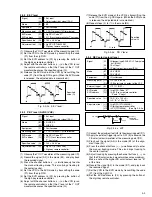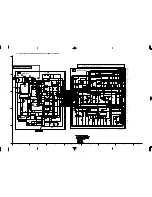
3-2
Fig. 3-1-5a EVR mode
FDP
3.2 SERVO CIRCUIT
3.2.1 Switching point
Signal
(A1)
•
Stairstep signal
(A2)
•
Alignment tape(SP, stairstep, PAL) [MHPE]
(A3)
•
Alignment tape(SP, stairstep, NTSC) [MHP]
Mode
(B)
•
PB
•
TBC: OFF
Equipment
(C)
•
Oscilloscope
Measuring point
(D1)
•
VIDEO OUT terminal (75
Ø
terminated)
(D2)
•
TP106 (PB FM)
External trigger
(E)
•
TP111 (D.FF)/slope : –
Adjustment part
(F)
•
Jig RCU: Code “51” or “52”
Specified value
(G)
•
8.0 ± 0.5H [MHPE]
•
7.5 ± 0.5H [MHP]
Adjustment tool
(H)
•
Jig RCU [PTU94023B]
(1) Play back the signal (A1) of the alignment tape (A2).
(2) Apply the external trigger signal to D.FF (E) to observe
the VIDEO OUT waveform and V.PB FM waveform at the
measuring points (D1) and (D2).
(3) Press the channel buttons (+, –) simultaneously to enter
the manual tracking mode. This also brings tracking to
the center (centre).
(4) Adjust tracking by pressing the channel buttons (+, –) so
that the V.PB FM waveform becomes maximum.
(5) Transmit the code (F) from the Jig RCU to adjust so that
the trigger point of the VIDEO OUT waveform is changed
from the trailing edge of the V.sync signal becomes the
specified value (G).
(6) Set the VCR to the stop mode or eject mode.
(7) Play back the signal (A1) of the alignment tape (A3).
(8) Repeat steps (2) to (6).
Fig. 3-2-1a Switching point
V.sync
Trigger point
Switching point
V. rate
3.2.2
Slow tracking preset
Signal
(A1)
•
Ext. input
(A2)
•
Color (colour) bar signal [PAL]
Mode
(B1)
•
S-VHS SP
(B2)
•
S-VHS LP
Measuring point
(D)
•
TV-Monitor
Adjustment part
(F)
•
Jig RCU: Code “71“ or “72”
Specified value
(G)
•
Minimum noise
Adjustment tool
(H)
•
Jig RCU [PTU94023B]
(1) Record the signal (A2) in the mode (B1), and play back
the recorded signal.
(2) Press the channel buttons (+, –) simultaneously to enter
the manual tracking mode. This also brings tracking to
the center (centre).
(3) Set the VCR to the FWD slow (+1/6
×
) mode.
(4) Transmit the code (F) from the Jig RCU to adjust so that
the noise bar becomes the specified value (G) on the TV
monitor in the slow mode.
(5) Set the VCR to the Stop mode.
(6) Confirm that the noise bar is (G) on the TV monitor in
the slow mode.
(7) Repeat steps (3) to (6) in the REV slow (–1/6
×
) mode.
(8) Repeat steps (1) to (7) in the mode (B2).
Note:
• For FWD slow (+1/6
×
) playback, transmit the code “08”
from the Jig RCU to enter the slow playback mode, and
transmit the code “D0” for REV slow (–1/6
×
) mode.
Fig. 3-3-1a D/A level
(1) Insert the cassette tape (A3) to enter the mode (B).
(2) Observe the Y OUT waveform at the measuring point (D).
(3) Check the Y level value when the External S-input (Y/C
separated video signal).
(4) Switch the input signal to the External input (composite
video signal), and adjust the adjustment part (F) so that
the Y level becomes the same value observed in step
(3).
Note:
• The specified value (G) is just a reference value to be
obtained when the External S-Video (Y/C separated
video) signal is input. In actual adjustment, set it to
the value observed in step (3).
3.3 VIDEO CIRCUIT
3.3.1
D/A level
Signal
(A1)
•
Ext. S-input / Ext. input
(A2)
•
Color (colour) bar signal [PAL]
(A3)
•
S-VHS tape
Mode
(B)
•
S-VHS
•
EE
Equipment
(C)
•
Oscilloscope
Measuring point
(D)
•
Y OUT terminal (75
Ø
terminated)
Adjustment part
(F)
•
VR1401 (D/A LEVEL ADJ)
[3D DIGITAL/2M board]
Specified value
(G)
•
1.00 ± 0.015 Vp-p (reference value)
(Note)
H. rate
Specified
value (G)
















































